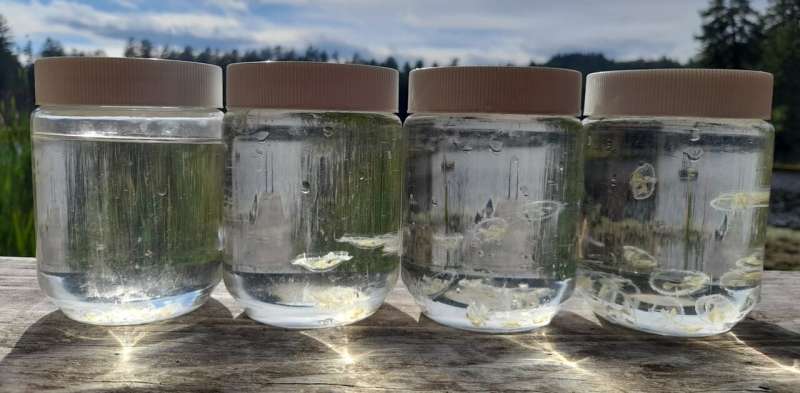This article has been reviewed according to Science X's editorial process and policies. Editors have highlighted the following attributes while ensuring the content's credibility:
fact-checked
trusted source
written by researcher(s)
proofread
How the peach blossom jellyfish is spreading across North America

Invasive species are a real problem in Canada, and one species in particular, the freshwater jellyfish species of the genus Craspedacusta sowerbii—C. sowerbii, or the peach blossom jellyfish—are as widespread as they are also poorly understood.
There is anecdotal evidence that the invasive jellyfish had been present in British Columbia lakes and ponds for decades. Still, compiled data suggest that the number of sightings has increased considerably since the year 2000.
Unfortunately, however, we still have very limited information about the range of its presence in Canada, how it got here, how it spreads and what its essential impact on freshwater ecosystems across Canada may be. No mitigation and management strategy has yet been developed and many fundamental questions about the species ecology are unanswered.
Climate change and species introductions
The Craspedacusta species is a subtropical but adaptable organism that favors moderate- to high-water temperatures. While cold water temperatures have acted as a historical check on their growth and expansion, warming temperatures around the globe are helping to expand their territory.
Recent increases in sightings of C. sowerbii in B.C., across Canada and worldwide are therefore indicative of an expanding suitable habitat for the jellyfish as a result of global warming, alongside a growing public awareness and increased observational efforts leading to more effective recognition.
Current modeling shows that the peach blossom jellyfish will expand to ever higher latitudes in both hemispheres over this century and be present in freshwater systems longer in the year from spring to late autumn.
Unfortunately, the species has rarely been the focus of research. Currently, as far as I am aware, only biological oceanographer Evgeny Pakhomov and I are now researching the species and its significance for Canada.
Our research shows that this trend is not restricted to B.C., but is expected to happen in other provinces such as Alberta, Ontario and Québec too. Craspedacusta sowerbii irregularly occurs in the Great Lakes area on both sides of the Canada-United States border since the 1930s.
Small invader, unpredictable occurrence
The current state of provincial monitoring and reporting on this species is, unfortunately, lackluster.
While a number of tools and data have been shown to be effective in monitoring populations in North America and Europe, no province currently includes these in annual reports and statistics.
For example, the Invasive Species Council of British Columbia's annual report does not cunduct large-scale data synthesis on the peach blossom jellyfish. As a result of this lack of data, no evidence of seasonal or long-term population trends exists.
Compounding these difficulties is the fact that the C. sowerbii is known as a species complex, meaning that there are likely several species going undetected under the same name. The nuances of these species distinctions are not only of academic interest, but also hold the key to identifying how these species move across and between ecosystems.
Understanding all of these aspects is crucial for us to start seriously thinking about mitigation and management strategies.
We cannot manage what we don't understand
While the species is harmless to humans, it is unknown how the freshwater jellyfish interact with other lake and pond inhabitants. There is evidence that these jellyfish are a potentially rich source of food for juvenile fish and they could compete with other native species as food.
Meanwhile, not enough up-to-date information is available about the various life stages of the jellyfish and the particular impacts of each stage. Indeed, while polyps and other juvenile stages are present year-round, their exact locations, abundance and activity levels are entirely unknown.
While governmental reporting infrastructure does exist in some provinces and territories, large-scale data have not yet been analyzed. Efforts are hampered by the lack of inclusion of the peach blossom jellyfish in regular monitoring programs.
We hope to stimulate interest and motivation to better understand this problem at all levels from federal to provincial governments and local municipalities.
This lack of data, and effort by provinces to collect them, has serious consequences for Canada's ecological security and limits the effectiveness of any management or adaptation plan in the years to come.
Provided by The Conversation
This article is republished from The Conversation under a Creative Commons license. Read the original article.![]()



















